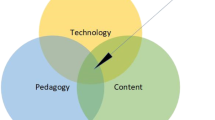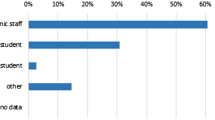Abstract
Purpose
Opal is a new patient-centered mobile application that gives cancer patients access to their real time medical data in conjunction with disease- and treatment-specific patient education material. Few studies have focused on patients’ experiences with such mobile applications. This study’s objectives were to (1) explore cancer patients’ perceptions of accessing the educational materials through Opal and (2) explore their experiences using these educational materials.
Methods
A qualitative descriptive design was used. Patients were invited to participate in the study via Opal itself. Semi-structured individual interviews were done in person or over the phone, transcribed verbatim and analyzed using qualitative content analysis.
Results
Nine women were interviewed. Three themes were identified as participants spoke about their perceptions of and experiences with Opal. First, Opal makes me feel like I have more control, conveying how learning more about their diagnosis and treatments allowed patients to advocate for themselves and plan their care. Second, Opal tends to reassure me, illustrating that having access to information was reassuring. Lastly, Opal is just starting to have information which could help meet my needs, reflecting patients’ belief Opal is on the right track but could provide more of their medical record, treating team contact information and education material.
Conclusion
Patients can feel more empowered when using patient-centered mobile applications, and mobile applications have potential for improving collaboration with healthcare professionals and care coordination. Healthcare professionals, including oncologists and nurses, should support patients’ use of mobile applications and integrate them in their patient interactions.



Similar content being viewed by others
Data availability
In accordance with the McGill University Health Centre Research Ethics Board, interview data will not be available, as this is a qualitative study and participant confidentiality needs to be maintained.
Code availability
Not applicable.
References
Mitchell AJ, Chan M, Bhatti H, Halton M, Grassi L, Johansen C, Meader N (2011) Prevalence of depression, anxiety, and adjustment disorder in oncological, haematological, and palliative-care settings: A meta-analysis of 94 interview-based studies. Lancet Oncol. https://doi.org/10.1016/S1470-2045(11)70002-X
Lorusso D, Bria E, Costantini A, Di Maio M, Rosti G, Mancuso A (2017) Patients’ perception of chemotherapy side effects: Expectations, doctor–patient communication and impact on quality of life – An Italian survey. Eur J Cancer Care. https://doi.org/10.1111/ecc.12618
Güleser G, Taşci S, Kaplan B (2012) The experience of symptoms and information needs of cancer patients undergoing radiotherapy. J Cancer Educ. https://doi.org/10.1007/s13187-011-0254-7
Papadakos J, McQuestion M, Gokhale A, Damji A, Trang A, Abdelmutti N, Ringash J (2018) Informational needs of head and neck cancer patients. J Cancer Educ. https://doi.org/10.1007/s13187-017-1176-9
Saroa O, Molzahn A, Northcott H, Schmidt K, Ghosh S, Olson K (2018) A survey of information needs and preferences of patients with head and neck cancer. Oncol Nurs Forum. https://doi.org/10.1188/18.ONF.761-774
Murray E, Burns J, See Tai S, Lai R, Nazareth I (2005) Interactive Health Communication Applications for people with chronic disease. Cochrane Database Syst Rev. https://doi.org/10.1002/14651858.CD004274.pub4
Government of Canada (2010) eHealth. Health care system. https://www.canada.ca/en/health-canada/services/health-care-system/ehealth.html. Accessed 7 Feb 2019
Baker TB, Hawkins R, Pingree S et al (2011) Optimizing eHealth breast cancer interventions: Which types of eHealth services are effective? Transl Behav Med. https://doi.org/10.1007/s13142-010-0004-0
Cooley ME, Nayak MM, Abrahm JL et al (2017) Patient and caregiver perspectives on decision support for symptom and quality of life management during cancer treatment: Implications for eHealth. Psychooncology. https://doi.org/10.1002/pon.4442
Harder H, Holroyd P, Burkinshaw L et al (2017) A user-centred approach to developing bWell, a mobile app for arm and shoulder exercises after breast cancer treatment. J Cancer Surviv. https://doi.org/10.1007/s11764-017-0630-3
Ruland CM, Maffei RM, Børøsund E, Krahn A, Andersen T, Grimsbø GH (2013) Evaluation of different features of an eHealth application for personalized illness management support: Cancer patients’ use and appraisal of usefulness. Int J Med Inform. https://doi.org/10.1016/j.ijmedinf.2013.02.007
Kildea J, Battista J, Cabral B, Hendren L, Herrera D, Hijal T, Joseph A (2019) Design and development of a person-centered patient portal using participatory stakeholder co-design. J Med Internet Res. https://doi.org/10.2196/11371
Opal Med Apps (2019) Laurie Hendren. https://opalmedapps.com/memoriam/memoriam.html. Accessed 19 Oct 2020
Birkhoff SD, Cantrell MA, Moriarty H, Lustig R (2018) The usability and acceptability of a patient-centered mobile health tracking app among a sample of adult radiation oncology patients. Adv Nurs Sci. https://doi.org/10.1097/ANS.0000000000000202
den Bakker CM, Schaafsma FG, Huirne JAF et al (2018) Cancer survivors’ needs during various treatment phases after multimodal treatment for colon cancer - Is there a role for eHealth? BMC Cancer. https://doi.org/10.1186/s12885-018-5105-z
Alvarez RC (2002) The promise of e-Health - a Canadian perspective. Ehealth international. https://doi.org/10.1186/1476-3591-1-4
Triberti S, Savioni L, Sebri V, Pravettoni G (2019) Ehealth for improving quality of life in breast cancer patients: A systematic review. Rev, Cancer Treat. https://doi.org/10.1016/j.ctrv.2019.01.003
Bradshaw C, Atkinson S, Doody O (2017) Employing a qualitative description approach in health care research. Glob Qual Nurs Res. https://doi.org/10.1177/2333393617742282
Sullivan-Bolyai S, Bova C, Harper D (2005) Developing and refining interventions in persons with health disparities: The use of qualitative description. Nurs Outlook. https://doi.org/10.1016/j.outlook.2005.03.005
Tong A, Sainsbury P, Craig J (2007) Consolidated criteria for reporting qualitative research (coreq): A 32-item checklist for interviews and focus groups. Int J Qual Health Care. https://doi.org/10.1093/intqhc/mzm042
Polit DF, Beck CT (2017) Nursing research: Generating and assessing evidence for nursing practice, 10th edn. Wolters Kluwer Health, Philadelphia
Gottlieb L (2013) Strengths-based nursing care: Health and healing for person and family. Springer, New York
Healthcare Information and Management Systems Society (2014) Patient engagement framework. https://www.himss.org/himss-patient-engagement-framework. Accessed 30 Jan 2019
Elo S, Kyngäs H (2008) The qualitative content analysis process. J Adv Nurs. https://doi.org/10.1111/j.1365-2648.2007.04569.x
Erlingsson C, Brysiewicz P (2017) A hands-on guide to doing content analysis. Afr J Emerg Med. https://doi.org/10.1016/j.afjem.2017.08.001
Carnevale FA (2002) Authentic qualitative research and the quest for methodological rigour. Can J Nurs Res. 34:121–128. http://cjnr.archive.mcgill.ca/article/view/1768/1765. Accessed 1 Feb 2019
Rexhepi H, Åhlfeldt R, Cajander A, Huvila I (2018) Cancer patients’ attitudes and experiences of online access to their electronic medical records: A qualitative study. Health Inform J. https://doi.org/10.1177/1460458216658778
Alpert JM, Morris BB, Thomson MD, Matin K, Brown RF (2018) Implications of patient portal transparency in oncology: Qualitative interview study on the experiences of patients, oncologists, and medical informaticists. J Med Internet Res cancer. https://doi.org/10.2196/cancer.8993
Powell K (2017) Patient-perceived facilitators of and barriers to electronic portal use. Computers Informatics Nursing. https://doi.org/10.1097/CIN.0000000000000377
Acknowledgements
We would like to thank the Opal design and development team, especially Dr. Tarek Hijal who was greatly involved in the creation of the Opal application, as well as Briana Cabral and Yick Kuan Mo for supporting and working with us during the recruitment phase of the study. We would also like to acknowledge Luc Galarneau for his editorial comments on our article. Lastly, we would like to thank the Cedars Cancer Foundation for providing patients with parking vouchers, allowing them to take part in in-person interviews.
Funding
Participant compensation (gift cards) and interview transcription was supported by funds held by the Research Institute of the McGill University Health Centre for Andréa Maria Laizner, RN, PhD. The Montreal General Hospital Foundation has contributed funds for partial salary support for Dr. Laizner. Sylvie Lambert, RN, PhD is funded by a CIHR Canada Research Chair.
Author information
Authors and Affiliations
Contributions
All authors contributed to the study conception and design. Material preparation, data collection and analysis were performed by Katherine Mohsen, Andréa Maria Laizner, Sylvie Lambert and John Kildea. The first draft of the manuscript was written by Katherine Mohsen and all authors commented on previous versions of the manuscript. All authors read and approved the final manuscript.
Corresponding author
Ethics declarations
Conflicts of interest/Competing interests
Dr. John Kildea declares he is a shareholder in a company, Opal Med Apps Inc., created to hold the intellectual property of Opal and possible future commercialization of the software.
Katherine Mohsen, Dr. Andréa Maria Laizner, and Dr. Sylvie Lambert have no conflict to declare.
Additional information
Publisher’s note
Springer Nature remains neutral with regard to jurisdictional claims in published maps and institutional affiliations.
Rights and permissions
About this article
Cite this article
Mohsen, K., Kildea, J., Lambert, S.D. et al. Exploring Cancer Patients’ Perceptions of Accessing and Experience with Using the Educational Material in the Opal Patient Portal. Support Care Cancer 29, 4365–4374 (2021). https://doi.org/10.1007/s00520-020-05900-4
Received:
Accepted:
Published:
Issue Date:
DOI: https://doi.org/10.1007/s00520-020-05900-4




